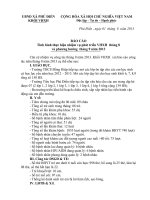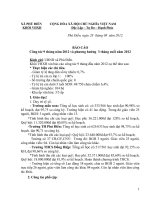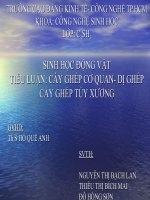ACL potx
Bạn đang xem bản rút gọn của tài liệu. Xem và tải ngay bản đầy đủ của tài liệu tại đây (683.3 KB, 18 trang )
© 2007 Cisco Systems, Inc. All rights reserved. ICND2 v1.0—6-1
Access Control Lists
Introducing ACL
Operation
© 2007 Cisco Systems, Inc. All rights reserved. ICND2 v1.0—6-2
Why Use ACLs?
Filtering: Manage IP traffic by filtering packets passing through a router
Classification: Identify traffic for special handling
© 2007 Cisco Systems, Inc. All rights reserved. ICND2 v1.0—6-3
ACL Applications: Filtering
Permit or deny packets moving through the router.
Permit or deny vty access to or from the router.
Without ACLs, all packets could be transmitted to all parts of your network.
© 2007 Cisco Systems, Inc. All rights reserved. ICND2 v1.0—6-4
Special handling for traffic based on packet tests
ACL Applications: Classification
© 2007 Cisco Systems, Inc. All rights reserved. ICND2 v1.0—6-5
Outbound ACL Operation
If no ACL statement matches, discard the packet.
© 2007 Cisco Systems, Inc. All rights reserved. ICND2 v1.0—6-6
A List of Tests: Deny or Permit
© 2007 Cisco Systems, Inc. All rights reserved. ICND2 v1.0—6-7
Types of ACLs
Standard ACL
–
Checks source address
–
Generally permits or denies entire protocol suite
Extended ACL
–
Checks source and destination address
–
Generally permits or denies specific protocols and applications
Two methods used to identify standard and
extended ACLs:
–
Numbered ACLs use a number for identification
–
Named ACLs use a descriptive name or number for identification
© 2007 Cisco Systems, Inc. All rights reserved. ICND2 v1.0—6-8
How to Identify ACLs
Numbered standard IPv4 lists (1–99) test conditions of all IP
packets for source addresses. Expanded range (1300–1999).
Numbered extended IPv4 lists (100–199) test conditions of source
and destination addresses, specific TCP/IP protocols, and destination
ports. Expanded range (2000–2699).
Named ACLs identify IP standard and extended ACLs with an
alphanumeric string (name).
© 2007 Cisco Systems, Inc. All rights reserved. ICND2 v1.0—6-9
IP Access List Entry Sequence
Numbering
Requires Cisco IOS Release 12.3
Allows you to edit the order of ACL statements using sequence numbers
–
In software earlier than Cisco IOS Release 12.3, a text editor is used to
create ACL statements, then the statements are copied into the router in
the correct order.
Allows you to remove a single ACL statement from the list using a sequence
number
–
With named ACLs in software earlier than Cisco IOS Release 12.3, you
must use no {deny | permit} protocol source source-wildcard
destination destination-wildcard to remove an individual statement.
–
With numbered ACLs in software earlier than Cisco IOS Release 12.3,
you must remove the entire ACL to remove a single ACL statement.
© 2007 Cisco Systems, Inc. All rights reserved. ICND2 v1.0—6-10
ACL Configuration Guidelines
Standard or extended indicates what can be filtered.
Only one ACL per interface, per protocol, and per direction is allowed.
The order of ACL statements controls testing, therefore, the most specific statements
go at the top of the list.
The last ACL test is always an implicit deny everything else statement, so every list
needs at least one permit statement.
ACLs are created globally and then applied to interfaces for inbound or outbound
traffic.
An ACL can filter traffic going through the router, or traffic to and from the router,
depending on how it is applied.
When placing ACLs in the network:
–
Place extended ACLs close to the source
–
Place standard ACLs close to the destination
© 2007 Cisco Systems, Inc. All rights reserved. ICND2 v1.0—6-11
Dynamic ACLs
Dynamic ACLs (lock-and-key): Users that want to traverse the router
are blocked until they use Telnet to connect to the router and are
authenticated.
© 2007 Cisco Systems, Inc. All rights reserved. ICND2 v1.0—6-12
Reflexive ACLs
Reflexive ACLs: Used to allow outbound traffic and limit inbound
traffic in response to sessions that originate inside the router
© 2007 Cisco Systems, Inc. All rights reserved. ICND2 v1.0—6-13
Time-Based ACLs
Time-based ACLs: Allow for access control
based on the time of day and week
© 2007 Cisco Systems, Inc. All rights reserved. ICND2 v1.0—6-14
Wildcard Bits: How to Check the
Corresponding Address Bits
0 means to match the value of the corresponding address bit
1 means to ignore the value of the corresponding address bit
© 2007 Cisco Systems, Inc. All rights reserved. ICND2 v1.0—6-15
Match for IP subnets 172.30.16.0/24 to 172.30.31.0/24.
Wildcard Bits to Match IP Subnets
Address and wildcard mask:
172.30.16.0 0.0.15.255
© 2007 Cisco Systems, Inc. All rights reserved. ICND2 v1.0—6-16
172.30.16.29 0.0.0.0 matches
all of the address bits
Abbreviate this wildcard mask
using the IP address preceded
by the keyword host
(host 172.30.16.29)
Wildcard Bit Mask Abbreviations
0.0.0.0 255.255.255.255
ignores all address bits
Abbreviate expression
with the keyword any
© 2007 Cisco Systems, Inc. All rights reserved. ICND2 v1.0—6-17
Summary
ACLs can be used for IP packet filtering or to identify traffic to assign it
special handling.
ACLs perform top-down processing and can be configured for
incoming or outgoing traffic.
You can create an ACL using a named or numbered ACL. Named or
numbered ACLs can be configured as standard or extended ACLs,
which determines what they can filter.
Reflexive, dynamic, and time-based ACLs add more functionality to
standard and extended ACLs.
In a wildcard bit mask, a 0 bit means to match the corresponding
address bit and a 1 bit means to ignore the corresponding address bit.
© 2007 Cisco Systems, Inc. All rights reserved. ICND2 v1.0—6-18









